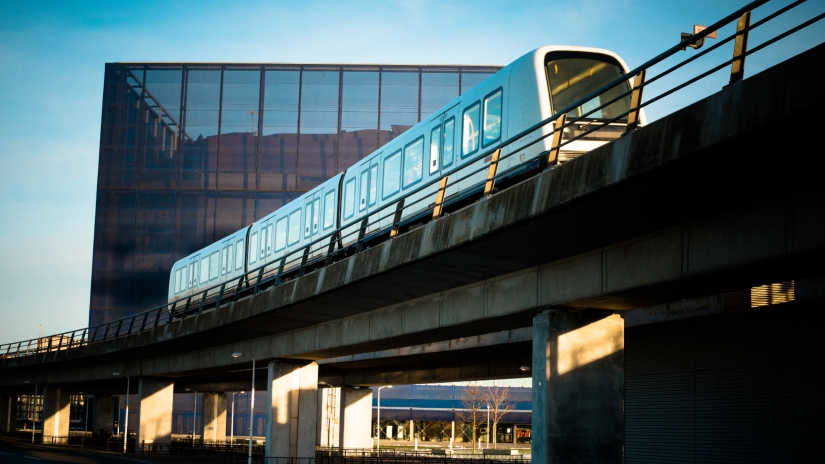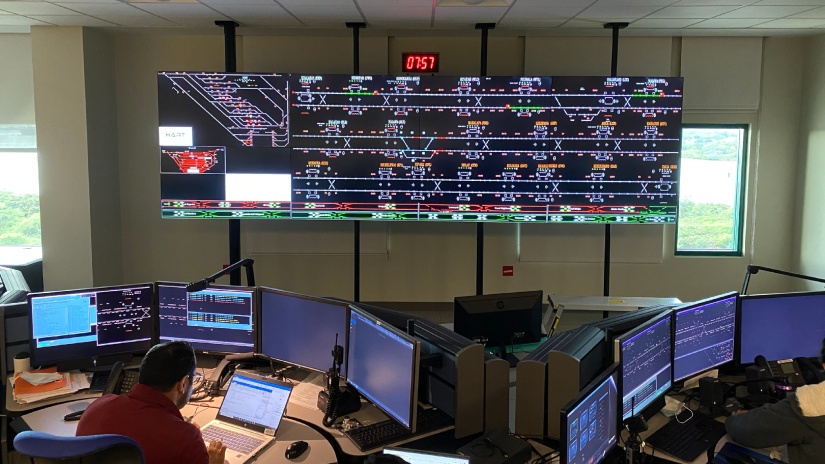By Domenico Fortinguerra, Project Director, Hitachi Rail Honolulu JV
Around the world congested roads are a major problem – and one that is getting worse. Drivers face a commute that’s noisy, polluted and increasingly congested, and are routinely spending more time getting to and from the office. All this takes a toll and adds up over time. In fact, a couple of Swiss economists found that long commutes led people to feel less happy about both their jobs and their lives.1
Commuters in Hawaii have first-hand familiarity with congestion. The H-1 freeway from Honolulu airport to downtown regularly sees some of the worst traffic jams in America.2
People now have an alternative thanks to a major mass transit program that’s created the first fully automated elevated rail system in the U.S.3 Passenger service began on June 30, 2023, allowing people to reach their destinations in a fraction of the time it currently takes.
The Skyline – as the new metro line has been named – is the latest example of a new autonomous mass transit system around the world. It embraces automatic train operations (ATO) that are safer, more efficient alternative to manually driven railroads and subways. The deployment of driverless technology means cleaner rail transportation with improved punctuality, reduced energy consumption and enhanced rail safety, notes Domenico Fortinguerra, Project Director, Hitachi Rail Honolulu JV.
“Passengers benefit from a more reliable and comfortable travel experience with optimized train schedules and improved passenger flow,” he said.
Hitachi Rail designs, builds and operates autonomous metro systems around the world. Its Cityringen metro in Copenhagen’s features automated train operations using CBTC (Communication-Based Train Control) technology that has led to more frequent services, improved reliability and shorter waiting times for passengers. Elsewhere, the Milan Metro in Italy has implemented automated train systems on Line 4 and Line 5 while Paris’ Metro transit system has also begun converting to driverless technology.4

Copenhagen Driverless Metro
While automated trains only comprise a relative fraction of the world's total rail-transit line length, that percentage is going to grow as more urban and regional authorities realize the advantages. Driverless trains reduce the chance of human error while improving rail efficiency and safety, along with increasing energy efficiency.
Of course, public perception often lags behind what is technologically possible. It took about half a century before people would ride in elevators without the presence of human operators. That changed following the 1945 strike of New York City’s elevator operators when the elevator industry decided to reinvent itself,5 ushering in the age of autonomous elevators.
Autonomous train proponents won’t need to wait so long.
Thanks to a myriad of technological advances on different fronts in the last decade – from better short-range communications technologies to the advent of 5G and the deployment of artificial intelligence – automated trains will usher in a new era in passenger travel.
Greater Safety: Automated systems feature enhanced safety features that use algorithms and cutting-edge sensors that monitor constantly and in real-time. The system makes autonomous decisions to minimize human errors, prioritize passenger safety and prevent accidents. Additionally, sensor data and predictive analytics help optimize maintenance schedules, further improving reliability.
Lower Carbon Footprint: While the transport sector accounts for 28% of total greenhouse gas emissions,6 trains emit up to nine times less CO27 and particulate matter emissions than road transport – and autonomous trains are even more energy-efficient. They reduce energy consumption by controlling speed and provide smoother changes of acceleration compared to manual control, lowering overall carbon footprints by reducing congestion.
A Boost for Smart Cities: Automated trains will drive investment in smart cities as systems are integrated into intelligent transportation networks and a more data-driven infrastructure. Optimized scheduling, precise control, and resource utilization mean faster travel times, better capacity utilization, and better energy management.
Transforming the Passenger Experience: Train amenities like Wi-Fi connectivity, charging stations and enhanced accessibility will become standard. Passengers will benefit from more comfortable rides with smoother transfers, improved punctuality, and more features, leading to more convenient, seamless and satisfying journeys.
Despite the progress and clear demonstration of the economic benefits of high-speed rail, there are challenges, such as infrastructure upgrades, safety considerations, and societal acceptance.
To make advanced signaling systems, like the CBTC, railroads may require upgraded communications networks. Improvements to power supply systems may also be needed, especially if train headways are reduced to provide more capacity. Signals and switches may need upgrading to meet the increased demands of automated systems for real-time monitoring.
Deployments will require speed sensors, obstacle detection systems, and condition monitoring devices that enable real-time data collection so the system can facilitate safe and efficient train movements.
Modern metros are operated by centralized train control centers, which provide remote operation, maintenance scheduling, and performance monitoring.
The transformation must also include providing training programs to railway staff, including maintenance personnel, and control center operators and passenger-facing teams.

Honolulu Skyline Control Center (Photo Credit: HART)
Honolulu Skyline is just one example of Hitachi delivering on the vision of fully integrated mobility and transport systems. As a leader in delivering fully integrated mobility and transport systems, Hitachi is at the forefront of the effort to provide the rail industry with innovative solutions that address the challenges of growing urbanization, congestion and climate change.
The firm collaborates with governments and customers to implement an automated train system projects around the world - the three most important factors being:
Thorough Planning and Feasibility Assessment: A comprehensive evaluation of the project's technical, operational, and financial feasibility to understand the benefits and challenges.
Infrastructure Readiness and Upgrades: Assess the existing railway infrastructure and determine the necessary upgrades to support automated train operations, such as advanced signaling and control systems, communication networks, and safety measures.
Stakeholder Engagement and Communication: Ensure effective communication with employees, passengers and regulatory authorities to address concerns, gain support, and maintain stakeholder engagement throughout the transition process, promoting a smooth and successful implementation.
These steps will ensure a smooth transition, while enhancing overall performance, reliability, and passenger experience in the upgraded railway system. Hitachi can help. From that point, it’s full speed ahead.

Project Director, Hitachi Rail Honolulu JV
Domenico is a seasoned project management expert with 17 years of valuable experience. Having worked extensively in various regions worldwide, including Far East Countries, Australia, Russian Federation, Middle East, and Central America, Domenico possesses a deep understanding of both onshore and offshore operations. His diverse background has honed his skills in effectively leading and motivating international project teams, enabling them to achieve exceptional performance. With a keen eye for the bigger picture, Domenico effortlessly identifies and prioritizes project goals, ensuring that they stay on track within the defined scope, schedule, and budget.